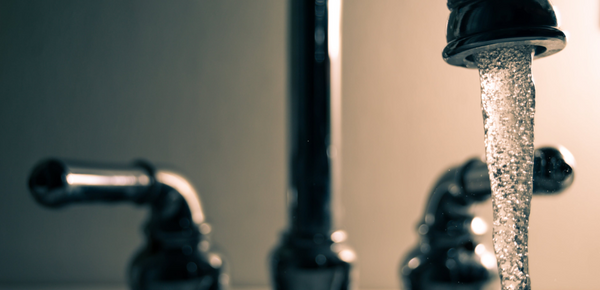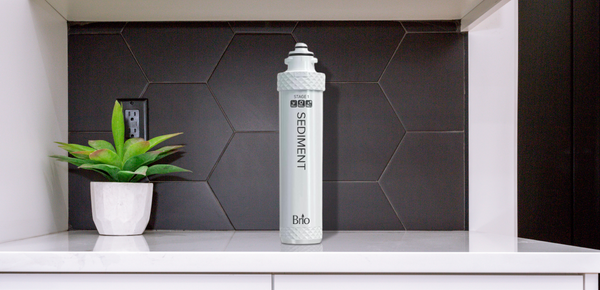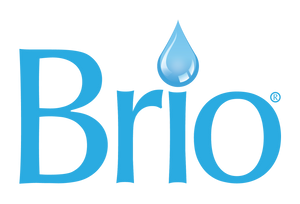Water, the elixir of life, sustains us in more ways than we can fathom. But what if the seemingly crystal-clear water flowing from our taps conceals a multitude of contaminants?
Help is at hand. Brio offers a variety of filtration systems, each designed to ensure your hydration supply is nothing short of confidence-inspiring. As for which water filter removes the most contaminants? Well, the best filter is the one that meets your specific needs.
Let’s delve into Brio’s advanced water filtration systems and break down how they work and which one removes the most contaminants.
What causes water contamination?
So, how does water get contaminated? To understand water contamination, we must go back to the source. When rain touches the earth, it journeys through soil, absorbing minerals, agricultural chemicals, per-and polyfluoroalkyl substances (PFAS, also known as forever chemicals), organic matter and bacteria along the way. It then enters the water system, where it encounters chlorine.
Finally it hits the pipes, where contaminants mercury and arsenic lurk in the shadows, evading detection in your regular tap water. According to the Centers for Disease Control and Prevention (CDC), the most common sources of lead in drinking water are lead pipes, faucets, and plumbing fixtures.

Unfiltered tap water may host a cast of undesirable characters, including toxic algae, lead, rust, chlorine, and general dirt. Human activities, industrial discharges, and aging infrastructure contribute to the contamination cocktail. Recognizing these sources equips us to tackle water purity challenges effectively.
Why is water contamination a problem?
Water contamination isn’t just a minor inconvenience; it poses a significant threat to our well-being. There are a huge number of contaminants that can appear in tap water, leading to health problems and water that doesn’t taste or smell good.
Heavy metals, forever chemicals, pesticides, bacteria and microplastics are some of the Top Contaminants & Chemicals Found In US Tap Water that can negatively affect the health of your family or workplace. Understanding the gravity of water contamination underscores the importance of reliable filtration systems.
Understanding what could be in your tap water
The quest for clean water involves understanding the contaminants it might harbor. Testing your water for pollutants ensures you’re armed with knowledge about its safety. Whether it’s harmful minerals, toxic chemicals, or chlorine, knowing what lurks in your water empowers you to make informed decisions about your filtration needs.

The Environmental Protection Agency (EPA) regulates municipal tap water and sets legal limits on certain contaminants. Not everyone agrees with those legal limits. For instance, the Environmental Working Group (EWG) thinks those legal limits should be much lower and encompass many more contaminants.
In addition, every water system differs, depending on the water treatment process, pipe systems and age and quality assurance protocols. So, even “clean” drinking water that flows from the faucet may not be what we would call healthy.
Want to know how to test water for contaminants? You can use the EWG's Tap Water Database to check the levels of contamination in your water supply.
Can you boil contaminated water?
The age-old practice of boiling water is a quick fix, but does it eliminate all contaminants? Boiling may address some microbial concerns, but it won’t rid your water of chemical pollutants, heavy metals, or other impurities.
For comprehensive purification, a robust filtration system is your best ally. Let’s have a look at what Brio has to offer.
Brio 2-Stage Advanced Filtration
In a nutshell … 2-stage filtration includes:
These filters will not eliminate healthy solids and salts, but can reduce heavy metals like lead and mercury, chlorine-resistant cysts like giardia and cryptosporidium, organic chemicals like herbicides, pesticides, and volatile organic compounds (VOCs), and pharmaceuticals like estrone and ibuprofen.
The set powerfully filters 0.8 gallons of water per minute for instant access to crisp and clean water at your convenience.
The 2-stage filter is very simple to use, so it is a breeze to remove and replace on your own in about 10 minutes as it only requires a water source, not a drain line.
The Brio Stage-1 Sediment Filter

Whether you’re on a municipal water system or you rely on a private well, sediment in your water can be a problem. Without some sort of filtration in place (even a faucet with a good aerator helps), you’re liable to see it coming out of your tap from time to time, so it’s a good idea to invest in a reliable sediment filter that will protect your plumbing and your other filters while improving the look and taste of your water.
What can it remove?
Sediment in your tap water does more than just create cloudy-looking and bad-tasting water. It can clog up and damage plumbing components and appliances. It also negatively impacts the efficiency of the other filters in a filtration system. They need a sediment filter in place doing its job so they can do theirs.
Sediment filters catch the “big stuff” so the other filters can intercept more worrisome and smaller contaminants like chlorine, lead, arsenic, bacteria, viruses, forever chemicals and pharmaceuticals.
In a multi-stage filtration system, incoming water encounters the sediment filter first. It’s typically referred to as a “mechanical filter” because it physically blocks debris or suspended solids from making it to either the faucet or to the next stage of the filtration process.
Debris, or sediment, is basically any solid that can be moved by a liquid and deposited somewhere else. Examples of debris are:
- rust flakes from pipes
- silt from storm runoff
- dirt churned up by water-line working being done down the street
- a water source with naturally high turbidity
- and even pollen.
How does it work?
The Brio Stage 1 Sediment Filter is a melt-blown polypropylene filter. High-velocity gas is blown through molten polymer, resulting in a filter cartridge built from its core out with intricately layered fibers.
As untreated water enters the filter housing, it passes through the filter’s meticulously layered wall which, because of its design, can block increasingly finer particulates – down to 5 microns in size.
To put 5 microns (or 0.00019685 of an inch) in perspective, 40 microns is the nominal threshold for naked-eye visibility. Here are additional comparisons:
- Grain of salt = 100 microns
- Single shaft of human hair = 50-90 microns
- Grain of talcum powder = 10 microns
- Red blood cell = 8 microns.
Stage 1-treated water is then pushed up through the filter's hollow center tube, and moved on to the next filter.
The Brio Stage-2 Pre Carbon Filter

Historically, one of the most common complaints about tap water is its taste: “like a swimming pool” is a descriptive phrase that frequently crops up. Chlorine and chlorine-based compounds, however, are the only disinfectants that can kill harmful microorganisms, including dangerous strains of E. coli, and bacteria that cause typhoid fever, cholera, and dysentery, to name a few scary waterborne illnesses.
Chlorine also reduces the risk of bacterial regrowth, maintaining safe water quality as water flows through municipal pipes and into homes. It’s for these reasons that more than 98% of water utilities in the U.S. use chlorine to disinfect drinking water.
That’s very good news. It means your water is safe to drink. But the problem is, you hate the chlorine taste. How do you remove it once water is safely inside your home?
What can it remove?
That’s where the Brio Stage-2 Pre Carbon Filter comes in. It’s a granular activated carbon (GAC) filter, and removing chlorine taste and odor is its main job.
The Brio Stage-2 Pre Carbon Filter traps compounds that give water an unpleasant taste and odor, such as chlorine and hydrogen sulfide (that rotten egg smell). It also filters out iron rust and small particulates that can affect the color or appearance of water, increasing your H2O’s clarity and reducing its turbidity. By the way, this process of getting stuck or trapped in the pores is called adsorption. And, yes, that's with a “d” not a “b!”
Like the Stage 1 Sediment Filter, the Stage 2 Pre Carbon Filter also protects and extends the life of the filters down the line, particularly the reverse osmosis membrane.
How does it work?
Brio uses coconut shell-based carbon, which is naturally porous. Not only are coconut shells more environmentally friendly than coal, but they’re also extremely high in carbon. After the coconut shells are ground up or milled, they’re steam-heated at 1000°C.
This whole process is called “activation”, with two results: The atoms that make up activated carbon create disordered layers filled with irregular pores, pockets, nooks, and crannies, while the surface area of the carbon is massively expanded (one teaspoon of granular activated carbon is equivalent to one soccer field).
Brio 3-Stage Advanced Filtration System
In a nutshell … 3-stage filtration includes:
The Brio 3-Stage Undersink Filtration System includes sediment filtration, carbon block filtration, and post carbon filtration to remove 99% of contaminants. Enjoy a plentiful supply of pure water on demand from a filtration system that produces zero wastewater and preserves essential minerals in your drinking water.
The multiple stages of filtration remove common contaminants like rust found in tap water. Like the two-stage filter process, this filter will also leave solids and salts like calcium, potassium, and magnesium and dissolve heavy metals like lead and mercury, chlorine-resistant cysts like giardia and cryptosporidium, organic chemicals like herbicides, pesticides, and VOCs.
A dedicated brushed nickel faucet keeps filtered water separate from tap water, plus the modern design looks great on any countertop.
The Brio Stage-3 Post Carbon Filter

What can it remove?
This advanced post carbon filter removes any possible residual taste and impurity from the water.
How does it work?
The 3-stage filter is very simple to use, so it is a breeze to remove and replace on your own in about 10 minutes as it only requires a water source, not a drain line.
Brio 4-Stage Ultrafiltration Filter System
In a nutshell … 4-stage ultrafiltration includes:
The main difference in the 3-stage versus the 4-stage filter set is the addition of the ultrafiltration step. Ultrafiltration is the next best thing to reverse osmosis filtration. It is very good at capturing things like E. coli. Another big benefit of ultrafiltration is that you don't have to install a wastewater line.
The Brio Ultrafiltration Membrane

What does it do?
Ultrafiltration is similar to reverse osmosis: the difference lies in the size of the molecules that are eradicated. Our ultrafiltration membrane has a micron rating of 0.1. Our reverse osmosis membrane has a micron rating of 0.0001. Ultrafiltration will remove contaminants like sediment, chlorine, and cysts as well as eradicating finer contaminants like lead, mercury, herbicides, pesticides, and VOCs. The ultrafiltration membrane does not remove total dissolved solids (TDS) – only a reverse osmosis membrane can do that. And, unlike reverse osmosis, it retains healthy minerals like calcium and magnesium.
How does it work?
Ultrafiltration filters out the solid particulate matter on a microscopic level by pushing the water molecules through a membrane. This membrane is a thin layer of material capable of separating the harmful materials from the healthy ones in your water supply. A driving force is applied across the membrane and pushes harmful solutes out while retaining solids and salts.
Brio 4-Stage Reverse Osmosis Filter System
In a nutshell … 4-stage reverse osmosis includes:
Stage 1 Sediment removes solid particulates like dirt, silt, sand, rust flakes, and other suspended solids. The main function of Stage 2 Pre Carbon (GAC) is to remove chlorine, as well as anything that causes unpleasant tastes and odors. For that reason, it's known as a CTO filter (chlorine, taste and odor). It can also remove VOCs.
Moving on to Stage 3: reverse osmosis. Its membrane is rated at 0.0001 microns, so it takes out just about everything. This powerful stage filters out TDS. Both good (calcium) and bad (arsenic) are in TDS.
Finally, Stage 4 Post Carbon. This takes out any lingering impurities, such as chlorine andVOCs, that may have slipped through. It won’t remove TDS, however.
Because the Stage-1 Sediment and Stage-2 Pre Carbon filters remove so many of the larger particulates, the high-grade Stage-3 reverse osmosis membrane only needs to be replaced every six to 12 months, depending on the quality of the source water and frequency of use.
And with the Brio reverse osmosis membrane, you'll enjoy up to 75 gallons a day of filtered water, so there’s no waiting for healthy hydration.
You will have to hook up a wastewater line to install a reverse osmosis cooler or system, which requires drilling into a drain pipe.
The Brio Stage-3 reverse osmosis membrane

If you are looking for water with a high degree of cleanliness, reverse osmosis is the best option. A Brio Stage-3 reverse osmosis membrane filter set is a perfect addition to any kitchen, ensuring your water will maintain a healthy level of salts and minerals while eliminating most dangerous contaminants.
What can it do?
Reverse osmosis filtration forces water through a membrane that traps contaminants, allowing fresh, pure water through.
How does it work?
Incoming water that’s been pre-filtered by the Stage-1 Sediment and Stage-2 Pre Carbon filters now enters the Stage-3 Reverse Osmosis Membrane, which is spiral wound and perforated with 0.0001-micron pores. A micron is one one-millionth of a meter. That’s mighty small.
As a comparison, the average pore diameter of human skin is 250 to 500 microns.
Unlike other types of filtration reverse osmosis requires a minimum level of water pressure. The water to be filtered has to be “reversed” out of its naturally occurring state of osmosis and squeezed through the porous membrane. The Brio Stage-3 Reverse Osmosis Membrane has a suggested psi (pounds per square inch) of 30 to 100.
Water is pushed through the filaments where it’s meticulously filtered by the pores. It then flows to the center of the housing, and up and out of the cartridge and onto the final polishing phase of filtration.
The Brio Stage-4 Post Carbon Filter

After three stages of filtration – sediment, pre carbon, and reverse osmosis – you might be wondering what’s left to remove from your water, since so many unpleasant tastes, odors, and impurities have already been filtered out.
Think of stage 4 as the water-perfecting phase. The function of the Brio Stage-4 Post Carbon Filter is to give your water its final polish by removing any particulates or pollutants that may have escaped the previous three stages.
What can it do?
Like the pre carbon filter, the post carbon filter tackles any residual sediment, colors, and chlorine, but it can also capture lingering forever chemicals that weren’t blocked by the reverse osmosis membrane. These ubiquitous contaminants have been shown to cause serious health issues, so the post carbon filter is a great backup for removing the final stragglers.
Additionally, the post carbon filter intercepts contaminants like insecticides, and herbicides. Post carbon, in other words, goes beyond impurities that affect taste and smell. It tackles the harmful stuff too.
When you dispense water purified by Brio Stage 4 filtration, you can be confident you'll be experiencing safe, clean, and absolutely delicious water.
How does it work?
Like the Stage 2 Pre-Carbon Filter, the Stage 4 Post Carbon Filter features activated carbon derived from coconut shells. However, the carbon in the post carbon filter is more finely ground than the granulated carbon in the pre-carbon filter. It has an almost powder-like consistency.
These powdered granules are then treated with a binding agent that holds their position, making them stable in relation to each other. They remain fixed in place as water moves across and through the densely packed medium. And each granule is loaded with nooks and crannies in which microscopic contaminants are swiftly trapped.
In a world where water purity is paramount, Brio’s range of filtration systems stands as a beacon of trust. From the initial sediment filter to comprehensive reverse osmosis, each stage plays a vital role in ensuring your water is free from contaminants while retaining essential minerals.
So, raise a glass of refreshingly pure water to Brio’s water filtration stages – the epitome of clean, safe, and delicious hydration. Happy hydrating!




